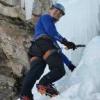How to Select the Best Hiking Socks: Tips from the Trail
Socks have more to do with your comfort while hiking than most of your other gear; however it seems like they sometimes can be an afterthought when packing for a trip. A good sock or a good sock system can prevent blisters and provide you with comfort in nearly any shoe. Selecting the right sock for you means you need to understand the different types of socks that are available.
Cotton, polyester/nylon, and wool are the three main types of fabrics used in socks. Cotton has gotten a bad reputation, but in dry environments, it is perfectly acceptable to wear cotton socks with ventilated shoes. However, if you may encounter any sort of wet weather, cotton is a negative insulator when wet, and is a bad idea to wear.

Wool socks continue to be a staple backpacking and hiking sock material for good reason.
Hiking Sock Material
For the same reason, since feet will always sweat, it is never a good idea to wear cotton with non-ventilated shoes. Polyester, nylon, and other synthetics (Lycra, etc.) are a better option. Synthetics do not absorb as much water as natural fibers, so if you're planning on getting your feet soaked and having to dry out your socks on a daily basis, they might be the best option. Synthetic socks also tend to be tougher than natural fibers. Lastly, wool has some interesting properties that make it almost ideal. It will absorb more water than synthetics, but even when saturated, it’s a positive insulator and will still keep your feet warm. Wool also will be the least smelly option for socks, and in my opinion has the best feel on your feet, as synthetics can feel slippery. Wool tends to wear out faster than synthetics under the same amount of use.
Single & 2-Layer Sock Systems for Backpacking & Hiking
For trail running, light hiking, and other flexible backpacking shoes, a single sock layer will normally do. I find a light cushioned sock like the Darn Tough Light Hiker socks in the quarter sock version is perfect for me, as it is mostly wool, but has some synthetic material as well to make it last longer and to give it a more elastic stretch. Others may prefer the micro crew sock (see our Darn Tough Light Hiker sock review) for additional above the ankle coverage. For any stiffer type of shoes, like mountaineering boots, or if you tend to get blisters easily, I find that a two sock system will eliminate most foot problems.
My preferred inner sock is the thinnest mid-calf wool sock I can find, like the Smartwool zero-cushion ski socks, and then I layer my normal Darn Tough quarter height socks on the outside. This helps eliminate the inner sock from getting scrunched up inside the boot and keeps the sock system from getting too thick, which may cause the shoes to fit too tight and cause other problems with blood circulation. I never recommend thick socks, as you should be selecting warmer footwear if you need more warmth.
Thick socks just tend to let your feet move around inside your shoe more after they've been crushed in, causing hot spots, or worse they compress your feet, leaving you with cold feet or numbness when circulation is reduced. Some socks are meant to compress your feet, but in a way that is evenly distributed. They can be nice in warm weather, but you should never wear a compression sock in cold weather as it can contribute to frost nip and frost bite.
Waterproof Hiking Socks
Lastly, everyone should carry a pair of waterproof socks. In an emergency, they can be placed on the outside of your inner sock, creating a vapor barrier liner that will help keep your feet warmer and in some cases drier. Two bread bags or a pair of stuff sacks can be used in a pinch if needed, but I find a nicer waterproof sock to be ideal, such as RAB’s vapor barrier socks.
In Conclusion
If all else fails and you do end up with a blister, our guide to hiking blisters has more information on blister care, as well as additional steps to take for blister prevention. That said, with a dialed-in sock and shoe system blisters should hopefully be far and few between. For more on additional clothing categories and with a backpacking focus, see our 3-season backpacking clothing guide. For a complete selection of backpacking and hiking socks that you can sort and filter by many of the features discussed in this article, take a look at this page at REI Co-op.
Editor's Note: This article by Ted "tmountainnut" Ehrlich originally appeared in Issue 23 of TrailGroove Magazine. You can read the original article here.


0 Comments
Recommended Comments
There are no comments to display.
Create an account or sign in to comment
You need to be a member in order to leave a comment
Create an account
Sign up for a new account in our community. It's easy!
Register a new accountSign in
Already have an account? Sign in here.
Sign In Now